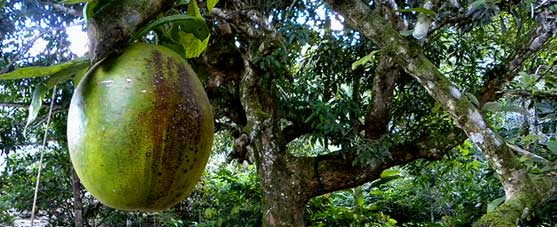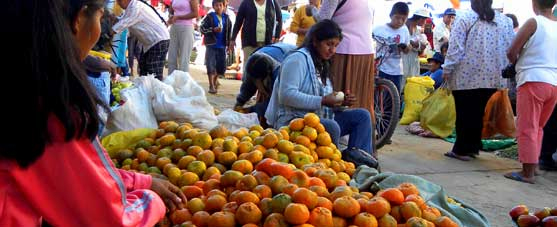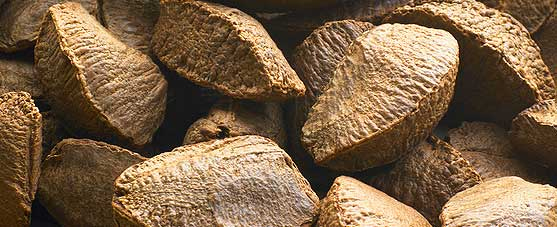|
|
Industrial-scale logging and resource exploitation continue to plague the South American rainforests, contributing to their systematic destruction. Today, indigenous inhabitants and other local residents of the rainforests and their surrounding areas, faced with the enormous pressures of the global economy, often find themselves in a crucible. Many of their opportunities for supporting themselves and their families financially involve logging or other large-scale operations that deplete and ultimately decimate the forests. In order to make even a marginal living, local people often find themselves forced to participate in the destruction of the very ecosystems that they live in and depend on. In fact, a recent study[1] in the prestigious journal Science has shown that while deforestation (in the Brazilian Amazon) generates some short-term benefits, it fails in the longer term to improve the quality of life or increase affluence. Thus, deforestation is NOT a critical step toward development. Instead, a two-pronged approach of compensation for allowing forest to stand coupled with development of sustainable activities that maintain biodiversity and ecosystem services will be of greater benefit. As the world seeks to mitigate global warming and carbon emissions, this latter approach will become more and more desirable and feasible.
 Nut often used for making drinking cups. |
At Amazon Fund, we believe that it is possible for people of the rainforest to gain a viable living from their environment in a way that is sustainable and healthy for the ecosystem. Some of the hope for the future of the forests, the plants, the animals, the people, and the knowledge of the Amazon lies in non-forest timber products.
NTFPs collected in a renewable and sustainable manner
Rich and intricate webs of life, rainforests clearly contain more than just wood for logging. Viewed through an economic lens, non-timber forest products (NTFPs) are any non-timber biological materials taken from forests for human use. NTFPs may be sold commercially or used for personal sustenance by the people harvesting them. Many NTFPs can be collected in a renewable and sustainable manner on a relatively small scale, providing local people with adequate income while preserving the forest. Potential Non-Timber Forest Products include herbs and other medicinal products, nuts, fruits, mushrooms, honey, gums and resins, spices, flavorings, sweeteners, fragrances for perfumes, ornamental pods and seeds, fibers, oils, food colorants, and rubber.
Sustainable harvesting more economically sound than a one-time timber harvest
As logging continues to destroy rainforests, forest inhabitants, activists, scientists, and others who care about the welfare of both the Amazon and the entire planet are searching for ways in which commercial harvesting, processing, and sale of non-forest timber products can be financially competitive with logging while remaining sustainable and directly involving and benefiting forest inhabitants. Peters et al[2] published a study in 1989 suggesting that the continued sustainable harvesting of fruit and rubber over time was more economically sound than a one-time timber harvest on a comparable piece of land. A Mongabay article[3] expanded on Peters’ math and calculated that, to date, the sustainably harvested land has been more than six times as lucrative as the one-time timber cut. This estimate is conservative because it is based on poorly developed markets and does not include less tried and true forest products that have a big profit potential.
 Gum from a tree |
Beyond the economic viability, there is tremendous value found in the sustainable management of the forest that is impossible to quantify. No one can, with any certainty or accuracy, put a dollar value on the role that functioning rainforest systems play in the health of our planet. Nor is it possible to put a price on families continuing to live in the forest, on the living knowledge of the forest and its products, on the continued existence of cultural groups and species of plants and animals. In addition to ethical considerations, there are very pragmatic reasons to foster the survival of Amazonian forests, plants, animals, people, and knowledge. The medicinal wealth contained in these forests is exhaustive and extremely valuable; it is impossible to predict when we might need it in the future.
Higher profit if the people have an active role in the retail
It is critical, both for the sake of the planet and the people, that the native people who live and work in the forests have ownership and control of the companies, coalitions, and cooperatives that they use to sell sustainable non-timber forest products. Exploitation and slavery are not conditions of the past. Even today, across the globe in innumerable industries, middlemen keep profits for themselves and leave the land ravaged and its inhabitants impoverished. Because indigenous and local people live in the forests and depend on them for survival, they have a vested interest in their preservation and long-term existence. Therefore, a business operated by those who live in and understand the forest is much more likely to be beneficial to the forest in the long run than one operated by people from far away whose priority is immediate profit, not the welfare of the land. By eliminating the middleman or using a non-profit as the intermediary, people can keep their prices competitive while reaping a significantly larger portion of the profits. Practices that are often not very profitable (for example, farming corn, cocoa, or coffee) can yield a much higher profit if the people engaging in them have an active role in the retail end of the process, cultivate in such a way that maximizes the potential of the land and ensures its continued fertility in years to come (employing practices such as shade growing, permaculture, etc), market to the right places, and certify their sustainable product officially (if it is organic or fair trade, for example) to make it more marketable and more lucrative.
In order for NTFPs to be a viable and sustainable source of income, those relying on them have to be conscientious and thoughtful about what, when, and how they harvest, and willing to diversify what they harvest and sell. The pau rosa tree was historically over-harvested for its fragrance. The whole tree was chopped down, but the fragrance is present in the leaves and twigs. Taking just leaves and twigs from the plants could bring in some money without killing trees. Harvesting a certain part of the plant in a thoughtful way ensures that the plant isn’t damaged and that the harvest has a relatively low impact. One could have an integrated and profitable set-up by engaging in some small-scale forest agriculture, harvesting different parts of various plants in a low-impact way throughout the year, and possibly being involved in local eco-tourism.
 Woman selling oranges on Bolivia market |
American farming translated to the Amazon
The “added-value” techniques that small-scale American farmers often employ to boost their profits could translate quite well to the Amazon. For example, at an average American farmer’s market, organic garlic might sell for $5.00 a pound, but a decorative garlic braid, simple in design and easy to produce quickly, will easily sell for $15 or $20, multiplying the income for the same quantity of garlic substantially beyond the increase in labor. Similarly, with creativity and a little effort, some by-products from forest industries or just from the forest itself could be easily, quickly, and profitably transformed into new products. For example, if seeds were being gathered for sale for plant propagation, seeds that were unlikely to sprout and which would otherwise be discarded could be used for jewelry or some other handicraft.
Eco-tourism could provide more opportunities
Eco-tourism is one service-based income option for people living in or near the rainforest. With the recent increase in environmental consciousness, more and more tourists want to see and experience firsthand the extraordinary natural features of the Amazon rainforest. If done properly, eco-tourism can have a low environmental impact. If indigenous people create and operate the eco-tourism initiatives, they can serve as a very personal cultural and environmental learning opportunity for tourists as well as a viable business for the people running them. Theoretically, enough people affected by positive eco-tourism experiences could have a longer-term, further-reaching impact on where money is going and even on the health of the planet. Small changes can have a positive impact. Additionally, eco-tourism could provide more opportunities for forest inhabitants to sell local NTFPs without having to rely on a middleman or the costs of export. Tourists coming through are bound to be interested in sampling local foods and bringing souvenirs back to their friends and families. This is also another opportunity for added-value techniques. Forest nuts might sell at a given price per pound, but if prepared in an appealing way, they could be marketed for a higher price.
Forest products are not the Holy Grail
Of course, complete reliance on NTFPs has its pitfalls. Many of the extractive reserves established specifically for the harvesting of NTFPs are used without consideration for sustainability, and even some “sustainable” efforts, particularly with crops like Brazil nuts, have not ultimately been so sustainable. Markets are easily flooded and saturated. To truly preserve the forest, output is limited. As more people become interested in harvesting NTFPs, doing so would have to become a supplementary income source in order to stay sustainable. Non-timber forest products are not the Holy Grail; they are just one piece of the puzzle, a dynamic puzzle that requires flexibility and foresight.
 Brazil nuts. Before Brazil was the worlds biggest exporter of Brazil nuts. Because of deforestation Brazil lost this position. Bolivia is world leader at the moment. |
They earn more than four times as much as in a standard “fair-trade” operation
The Kallari cooperative of Ecuador is an excellent example of a highly successful indigenous-operated collective based around forest agriculture and NTFPs. In its twelve years of operation, Kallari has expanded from 50 families to 850 families, who earn more than four times as much as they would in a standard “fair-trade” operation. At the same time, they are preserving the their rainforest and some of the traditional Kichwa ways by relearning handicrafts that can then be sold. One of the hallmarks to Kallari’s success is its flexibility and appropriate response to changing markets, demands, and situations. Kallari currently integrates cocoa farming with other NTFP-derived products, such as jewelry made from forest seeds and fibers. The cooperative seems amenable to making changes over time depending on the market, the forest, and the people. Kallari serves as one potential model for viable incorporation of NTFPs in efforts to preserve the rainforests.
As we work to decrease the deforestation of South American rainforests, we see that non-timber forest products could play a valuable role in the solution. Amazon Fund seeks to support sustainable use of NTFPs in its mission to preserve the forests.
Amazon Fund
REFERENCES
1. Deforestation Doesn’t Help Communities Become wealthier, healthier, or better educated.
Ana S. L. Rodrigues, Robert M. Ewers, Luke Parry, Carlos Souza Jr., Adalberto Veríssimo, 6 Andrew Balmford1. Boom-and-Bust Development Patterns Across the Amazon Deforestation Frontier. SCIENCE VOL 324 12 JUNE 2009.
2. Peters, C.M., Gentry, A.H., and Mendelsohn, R.O., “Valuation of an Amazonian Rainforest,” Nature Vol. 339: 655-656 1989
3. The Harvest of Sustainable Forest Products. Mongabay.com.